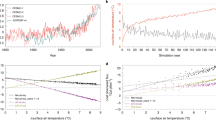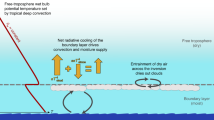Abstract
Equilibrium climate sensitivity to a doubling of CO2 falls between 2.0 and 4.6 K in current climate models, and they suggest a weak increase in global mean precipitation. Inferences from the observational record, however, place climate sensitivity near the lower end of this range and indicate that models underestimate some of the changes in the hydrological cycle. These discrepancies raise the possibility that important feedbacks are missing from the models. A controversial hypothesis suggests that the dry and clear regions of the tropical atmosphere expand in a warming climate and thereby allow more infrared radiation to escape to space. This so-called iris effect could constitute a negative feedback that is not included in climate models. We find that inclusion of such an effect in a climate model moves the simulated responses of both temperature and the hydrological cycle to rising atmospheric greenhouse gas concentrations closer to observations. Alternative suggestions for shortcomings of models — such as aerosol cooling, volcanic eruptions or insufficient ocean heat uptake — may explain a slow observed transient warming relative to models, but not the observed enhancement of the hydrological cycle. We propose that, if precipitating convective clouds are more likely to cluster into larger clouds as temperatures rise, this process could constitute a plausible physical mechanism for an iris effect.
This is a preview of subscription content, access via your institution
Access options
Subscribe to this journal
Receive 12 print issues and online access
$259.00 per year
only $21.58 per issue
Buy this article
- Purchase on Springer Link
- Instant access to full article PDF
Prices may be subject to local taxes which are calculated during checkout




Similar content being viewed by others
Change history
25 February 2016
In the version of the Perspective originally published, there were errors in the Supplementary Information. After correcting these, the reported correlations between actual climate change feedback and tropical regression in the sentence beginning 'In the analysis of the CMIP5 ensemble presented here...' are +0.38 and +0.32 for the AMIP and historical experiments, respectively. In addition, the subsequent statement now reads: 'Of the eleven models that match CERES net regression in either experiment, four have ECS above 3 K and seven below. When run with a prescribed evolution of sea surface temperatures (AMIP) only the two versions of the Beijing Climate Center (BCC) model match observations in the slope of the regression between net, longwave and shortwave radiation with temperature. If run in coupled mode (historical) only one version of the Goddard Institute for Space Studies (GISS-E2-H) model matches CERES data.' The authors acknowledge David Coppin for pointing out these errors. These errors have been corrected in the online versions of the Perspective.
References
Lindzen, R. S., Chou, M-D. & Hou, A. U. Does the Earth have an adaptive infrared iris? Bull. Am. Meteorol. Soc. 82, 417–432 (2001).
Hartmann, D. L. & Michelsen, M. L. No evidence for iris. Bull. Am. Meteorol. Soc. 83, 249–254 (2002).
Lau, K. M. & Wu, H. T. Warm rain processes over tropical oceans and climate implications. Geophys. Res. Lett. 30, 1944–8007 (2003).
Rapp, A. D., Kummerow, C., Berg, W. & Griffith, B. An evaluation of the proposed mechanism of the adaptive infrared iris hypothesis using TRMM VIRS and PR measurements. J. Clim. 18, 4185–4194 (2005).
Rondanelli, R. & Lindzen, R. S. Observed variations in convective precipitation fraction and stratiform area with sea surface temperature. J. Geophys. Res. 113, D16119 (2008).
Lindzen, R. S. & Choi, Y-S. On the determination of climate feedbacks from ERBE data. Geophys. Res. Lett. 36, L16705 (2009).
Trenberth, K. E., Fasullo, J. T., O'Dell, C. & Wong, T. Relationships between tropical sea surface temperature and top-of-atmosphere radiation. Geophys. Res. Lett. 37, L03702 (2010).
Lindzen, R. S. & Choi, Y-S. On the observational determination of climate sensitivity and its implications. Asia-Pacif. J. Atmos. Sci. 47, 377–390 (2011).
Su, H. et al. Variations of tropical upper tropospheric clouds with sea surface temperature and implications for radiative effects. J. Geophys. Res. 113, D10211 (2008).
Rondanelli, R. & Lindzen, R. S. Comment on 'Variations of tropical upper tropospheric clouds with sea surface temperature and implications for radiative effects by H. Su et al.' J. Geophys. Res. 115, D06202 (2009).
Collins, M et al. in Climate Change 2013: The Physical Science Basis. (eds Stocker, T. F. et al.) 1029–1136 (IPCC, Cambridge Univ. Press, 2013).
Fu, Q., Baker, M. & Hartmann, D. L. Tropical cirrus and water vapor: An effective Earth infrared iris feedback? Atmos. Chem. Phys. 2, 31–37 (2002).
Lin, B., Wielicki, B. A., Chambers, L. H., Hu, Y. & Xu, K-M. The iris hypothesis: A negative or positive cloud feedback? J. Clim. 15, 3–7 (2002).
Dessler, A. E. Observations of climate feedbacks over 2000–10 and comparison to climate models. J. Clim. 26, 333–342 (2013).
Forster, P. M. & Gregory, J. M. The climate sensitivity and its components diagnosed from earth radiation budget data. J. Clim. 19, 39–52 (2006).
Block, K. & Mauritsen, T. Forcing and feedback in the MPI-ESMLR coupled model under abruptly quadrupled CO2 . J. Adv. Model. Earth Syst. 5, 1–16 (2013).
Clement, A. C. & Soden, B. The sensitivity of the tropical-mean radiation budget. J. Clim. 18, 3189–3203 (2005).
Nilsson, J. & Emanuel, K. Equilibrium atmospheres of a two-column radiative-convective model. Q. J. R. Meteorol. Soc. 125, 2239–2264 (1999).
Emanuel, K., Wing, A. A. & Vincent, E. M. Radiative-convective instability. J. Adv. Model. Earth Syst. http://dx.doi.org/10.1002/2013MS000270 (2014).
Trenberth, K. E. Atmospheric moisture residence times and cycling: Implications for rainfall rates and climate change. Clim. Change 39, 667–694 (1998).
Bretherton, C. S., Blossey, P. N. & Khairoutdinov, M. An energy balance analysis of deep convective self-aggregation above uniform SST. J. Atmos. Sci. 62, 4273–4292 (2005).
Tobin, I., Bony, S. & Roca, R. Observational evidence for relationship between the degree of aggregation of deep convection, water vapor, surface fluxes and radiation. J. Clim. 25, 6885–6904 (2012).
Muller, C. J. & Held, I. M. Detailed investigation of the self-aggregation of convection in cloud-resolving simulations. J. Clim. 69, 2551–2565 (2012).
Satoh, M., Iga, S-I., Tomita, H., Tsushima, Y. & Noda, A. T. Response of upper clouds in global warming experiments obtained using a global nonhydrostatic model with explicit cloud processes. J. Clim. 25, 2178–2191 (2012).
Tsushima, Y. et al. High cloud increase in a perturbed SST experiment with a global nonhydrostatic model including explicit convective processes. J. Adv. Model. Earth Syst. http://dx.doi.org/10.1002/2013MS000301 (2014).
Klocke, D., Pincus, R. & Quaas, J. On constraining estimates of climate sensitivity with present-day observations through model weighting. J. Clim. 24, 6092–6099 (2011).
Stevens, B. & Bony, S. Water in the atmosphere. Phys. Today 66 (6), 29–34 (2013).
Vial, J., Dufresne, J-L. & Bony, S. On the interpretation of inter-model spread in CMIP5 climate sensitivity estimates. Clim. Dyn. 41, 3339–3362 (2013).
Clement, A., Burgman, R. & Norris, J. Observational and model evidence for positive low-level cloud feedback. Science 325, 460–464 (2009).
Rieck, M., Nuijens, L. & Stevens, B. Marine boundary layer cloud feedbacks in a constant relative humidity atmosphere. J. Atmos. Sci. 69, 2538–2550 (2012).
Fasullo, J. T. & Trenberth, K. E. A less cloudy future: The role of subtropical subsidence in climate sensitivity. Science 338, 792–794 (2012).
Sherwood, S. C., Bony, S. & Dufresne, J-L. Spread in model climate sensitivity traced to atmospheric convective mixing. Nature 505, 37–42 (2014).
Su, H. et al. Weakening and strengthening structures in the Hadley Circulation change under global warming and implications for cloud response and climate sensitivity. J. Geophys. Res. Atmos. 119, 5787–5805 (2014).
Otto, A. et al. Energy budget constraints on climate response. Nature Geosci. 6, 415–416 (2013).
Skeie, R. B., Berntsen, T., Aldrin, M., Holden, M. & Myhre, G. A lower and more constrained estimate of climate sensitivity using updated observations and detailed radiative forcing time series. Earth Syst. Dynam. 5, 139–175 (2014).
Lewis, N. & Curry, J. A. The implications for climate sensitivity of AR5 forcing and heat uptake estimates. Clim. Dynam. http://doi.org/3hn (2014).
Haimberger, L., Tavolato, C. & Sperka, S. Homogenization of the global radiosonde temperature dataset through combined comparison with reanalysis background series and neighboring stations. J. Clim. 25, 8108–8131 (2012).
Po-Chedley, S. & Fu, Q. Discrepancies in tropical upper tropospheric warming between atmospheric circulation models and satellites. Environ. Res. Lett. 7, 044018 (2012).
Newell, R. E., Herman, G. F., Gould-Stewart, S. & Tanaka, M. Decreased global rainfall during the past ice age. Nature 253, 33–34 (1975).
Held, I. M. & Soden, B. J. Robust responses of the hydrological cycle to global warming. J. Clim. 19, 5686–5699 (2006).
Zhang, X. et al. Detection of human influence on twentieth-century precipitation trends. Nature 448, 461–466 (2007).
Lambert, F. H., Stine, A. R., Krakauer, N. Y. & Chiang, J. C. H. How much will precipitation increase with global warming? EOS 89, 193200 (2008).
Durack, P. J., Wijffels, S. E. & Matear, R. J. Ocean salinities reveal strong global water cycle intensification during 1950 to 2000. Science 336, 455–458 (2012).
Ren, L., Arkin, P., Smith, T. M. & Shen, S. S. P. Global precipitation trends in 1900–2005 from a reconstruction and coupled model simulations. J. Geophys. Res. Atmos. 118, 1679–1689 (2013).
Johanson, C. M. & Fu, Q. Hadley cell widening: Model simulations versus observations. J. Clim. 22, 2713–2725 (2009).
Shindell, D. T. Inhomogeneous forcing and transient climate sensitivity. Nature Clim. Change 4, 274–277 (2014).
Santer, B. D. et al. Volcanic contribution to decadal changes in tropospheric temperature. Nature Geosci. 7, 185–189 (2014).
Trenberth, K. E. & Fasullo, J. T. Tracking Earth's energy. Science 328, 316–317 (2010).
Ramanathan, V., Crutzen, P. J., Kiehl, J. T. & Rosenfeld, D. Aerosols, climate, and the hydrological cycle. Science 294, 2119–2124 (2001).
Llovel, W., Willis, J. K., Landerer, F. W. & Fukumori, I. Deep-ocean contribution to sea level and energy budget not detectable over past decade. Nature Clim. Change 4, 1031–1035 (2014).
Acknowledgements
Contributions from S. Bony, P. Forster, Quiang Fu, A. Gettelman, J. Gregory, I. Held, S. Klein, R. Lindzen, R. Pierrehumbert, S. Po-Chedley, D. Popke, F. Rauser, S. Sherwood and M. Zelinka were valuable in advancing this study. CERES data were obtained from the NASA Langley Research Center, HadCRUT4 data are provided by the Met Office Hadley Centre and the Climatic Research Unit at the University of East Anglia, and CMIP5 data from the coupled modelling groups (Supplementary Table 3) coordinated by the World Climate Research Programme's Working Group on Coupled Modelling. This work was supported by the Max-Planck-Gesellschaft (MPG) and by funding through the EUCLIPSE project from the European Union, Seventh Framework Programme (FP7/2007-2013) under grant agreement no. 244067. Computational resources were made available by Deutsches Klimarechenzentrum (DKRZ) through support from Bundesministerium für Bildung und Forschung (BMBF).
Author information
Authors and Affiliations
Corresponding author
Supplementary information
Supplementary Information
Supplementary information (PDF 22460 kb)
Rights and permissions
About this article
Cite this article
Mauritsen, T., Stevens, B. Missing iris effect as a possible cause of muted hydrological change and high climate sensitivity in models. Nature Geosci 8, 346–351 (2015). https://doi.org/10.1038/ngeo2414
Received:
Accepted:
Published:
Issue Date:
DOI: https://doi.org/10.1038/ngeo2414
This article is cited by
-
Recent global nonhydrostatic modeling approach without using a cumulus parameterization to understand the mechanisms underlying cloud changes due to global warming
Progress in Earth and Planetary Science (2023)
-
Radiative effects of observationally constrained tropical upper-level clouds in a radiative-convective equilibrium model
Climate Dynamics (2023)
-
Precipitation efficiency constraint on climate change
Nature Climate Change (2022)
-
Model spread in tropical low cloud feedback tied to overturning circulation response to warming
Nature Communications (2022)
-
On the future zonal contrasts of equatorial Pacific climate: Perspectives from Observations, Simulations, and Theories
npj Climate and Atmospheric Science (2022)



